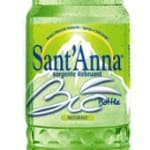 Fonti Di Vinadio is getting ready to launch 50 million half-liter "biobottles" made from the polylactic acid Ingeo by Natureworks. One-and-a-half liter bottles are also forecast.
Fonti Di Vinadio is getting ready to launch 50 million half-liter "biobottles" made from the polylactic acid Ingeo by Natureworks. One-and-a-half liter bottles are also forecast.This fall, the Italian spring-water bottling company, Fonti di Vinadio, will introduce a new biodegradable bottles made from polylactic acid (PLA) Ingeo manufactured by the American company Natureworks LCC. Ingeo has already been used for manufacturing bottles in Ireland and Canada. It is a material obtained from renewable sources that complies with the European standard UNI EN 13432 for the compostability of packaging.
Alberto Bertone, CEO and President of Fonti di Vinadio, is finishing the last details of the agreement with the large distributor for the sale of the new bottles, which the company also intends to sell abroad.

The company`s strategy, given the controversy about the introduction of bioplastics in the packaging collection and recycling chain, is marked by caution. Initially, a limited number of the new "biobottles" (that is what the company has chosen to call them) will be introduced, about 50 million half-liter bottles during the first 12 months. The bottles will be distinguished from those in PET both by their label and by color, which will be green (photo). Furthermore, distribution will be limited to a specific geographic area. This will allow the company to monitor the impact of the new product on the market and the reactions of the consumers.
After the initial experimental phase, Fonti di Vinadio expects to put a "much larger number of bottles on the shelves. The volume will essentially depend on the market`s reaction during the launch phase - explained Bertone.
Bertone stated that the company is ready to launch a 1.5 liter bottle on the market (500,000 test bottles have already been produced) following a long period fine-tuning the preform and bottle blow molding processes, which allowed them to successfully resolve the structural difficulties they had due to the lower mechanical resistance of the biopolymer. They have been so successful in this that today the half-liter "biobottles" - states the company - has performance similar to that of the standard PET packaging.


